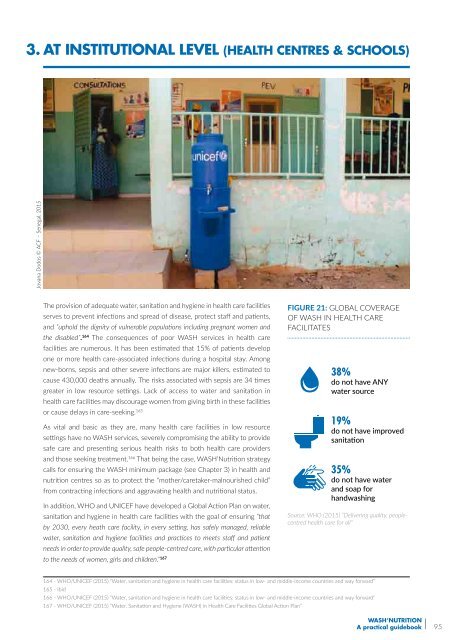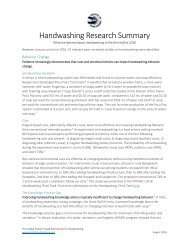WASH’ Nutrition
manuel_wash_nutrition_online
manuel_wash_nutrition_online
Create successful ePaper yourself
Turn your PDF publications into a flip-book with our unique Google optimized e-Paper software.
3. AT INSTITUTIONAL LEVEL (HEALTH Centres & SCHOOLS)<br />
Jovana Dodos © ACF – Senegal, 2015<br />
The provision of adequate water, sanitation and hygiene in health care facilities<br />
serves to prevent infections and spread of disease, protect staff and patients,<br />
and “uphold the dignity of vulnerable populations including pregnant women and<br />
the disabled”. 164 The consequences of poor WASH services in health care<br />
facilities are numerous. It has been estimated that 15% of patients develop<br />
one or more health care-associated infections during a hospital stay. Among<br />
new-borns, sepsis and other severe infections are major killers, estimated to<br />
cause 430,000 deaths annually. The risks associated with sepsis are 34 times<br />
greater in low resource settings. Lack of access to water and sanitation in<br />
health care facilities may discourage women from giving birth in these facilities<br />
or cause delays in care-seeking. 165<br />
As vital and basic as they are, many health care facilities in low resource<br />
settings have no WASH services, severely compromising the ability to provide<br />
safe care and presenting serious health risks to both health care providers<br />
and those seeking treatment. 166 That being the case, <strong>WASH’</strong><strong>Nutrition</strong> strategy<br />
calls for ensuring the WASH minimum package (see Chapter 3) in health and<br />
nutrition centres so as to protect the “mother/caretaker-malnourished child”<br />
from contracting infections and aggravating health and nutritional status.<br />
In addition, WHO and UNICEF have developed a Global Action Plan on water,<br />
sanitation and hygiene in health care facilities with the goal of ensuring “that<br />
by 2030, every heath care facility, in every setting, has safely managed, reliable<br />
water, sanitation and hygiene facilities and practices to meets staff and patient<br />
needs in order to provide quality, safe people-centred care, with particular attention<br />
to the needs of women, girls and children.” 167<br />
Figure 21: Global coverage<br />
of WASH in health care<br />
facilitates<br />
38%<br />
do not have ANY<br />
water source<br />
19%<br />
do not have improved<br />
sanitation<br />
35%<br />
do not have water<br />
and soap for<br />
handwashing<br />
Source: WHO (2015) “Delivering quality, peoplecentred<br />
health care for all”<br />
164 - WHO/UNICEF (2015) “Water, sanitation and hygiene in health care facilities: status in low- and middle-income countries and way forward”<br />
165 - Ibid<br />
166 - WHO/UNICEF (2015) “Water, sanitation and hygiene in health care facilities: status in low- and middle-income countries and way forward”<br />
167 - WHO/UNICEF (2015) “Water, Sanitation and Hygiene (WASH) in Health Care Facilities Global Action Plan”<br />
<strong>WASH’</strong><strong>Nutrition</strong><br />
A practical guidebook<br />
95



